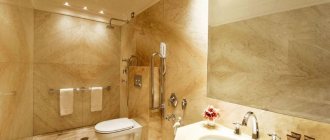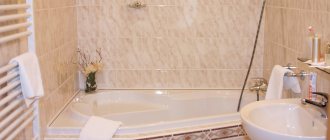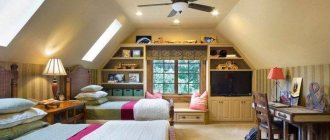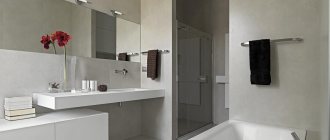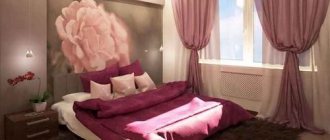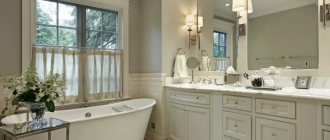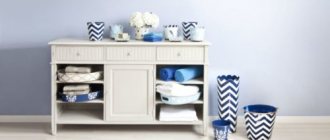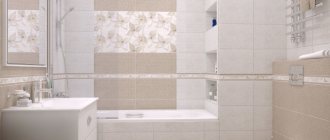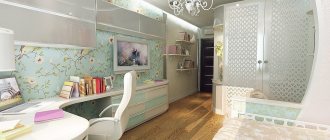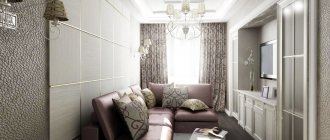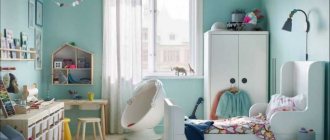Tips for renovating a white bathroom
In conclusion, let's look at some tips from experienced designers:
- Do not overload the room with various decorative elements. This will cause a visual overload effect that will completely ruin the impression of the room.
- The bathroom must be kept in the same style without sharp transitions. Otherwise, you will end up with a bathroom that is too contrasting and will look awkward.
- If you use photo wallpaper, give preference to original abstract designs and patterns. If you use wallpaper with a landscape, then remember that in a couple of years this design will go out of fashion, and the design (for example, in the form of a flower) will be perceived as kitsch.
Disadvantages of solid wood decor
Despite the undeniable advantages of wooden elements in bathrooms, this material has a number of disadvantages:
- The most significant criterion that is decisive when refusing to purchase a wooden bathtub is its cost. Depending on the manufacturer, type of wood, manufacturing method, volume of the product, the price for this type of plumbing equipment can reach two million rubles.
- Wood is a natural material; it perfectly absorbs various substances and fats, which means that in such a font it will not be possible to wash your four-legged friend, rinse clothes or use scrubs, oils and other specialized body products. Wood requires delicate handling, and therefore is intended more for taking relaxing baths, filled with natural healing and relaxing effects on the body, which in turn means the need for a shower cabin or a second bathroom in your home.
- No matter how high-quality the purchased product is, it requires careful care for long-term operation. Its polymer coating or polishing needs regular updating every 3-5 years, which the manufacturer and seller will warn you about.
Styles using wood
The use of wood to decorate a bathtub is suitable for any style, even for a modern or exotic option.
- The rustic style is dictated by the material itself. Beautiful wood patterns and furniture made from heavy boards will create a unique flavor.
- A classic style will be created by light wood. Wooden walls combined with a bathtub with graceful legs and fittings with curved lines, as well as furniture in a similar style, will create a feeling of luxury and opulence of the ancient era.
- Scandinavian style will look very warm and cozy in such a bath. Warm brown tones of different shades, several light sources of different tones will create unforgettable comfort.
- Japanese style will bring concentration and asceticism to the room. Black wood combined with white tiles or contrasting tones of wood and sanitary ware will turn the bath into the room of a Japanese geisha. An interesting option would be to combine gray wood and cherry tiles.
Regardless of the style, wood brings warmth and coziness to the bath.
Selection of materials
The modern market offers a variety of shapes and materials to realize the idea of wooden decorative elements in the bathroom.
Natural wood species
The most environmentally friendly, stylish and solid option is natural solid wood.
Finishing walls, floors or ceilings using teak, pine, oak, Brazil walnut or beech is moisture-resistant, reliable and durable. You can safely use it near water sources and not be afraid of damage to its appearance.
Plumbing items made of wood should be made from the most moisture-resistant solids: teak, walnut, oak
Bathroom furniture is made from cedar, mahogany or larch. These tree species are less reliable than those mentioned above, but they do their job well in the form of cabinets, drawers, and stands.
Bathroom furniture is made from cedar, larch or mahogany
Interesting! Teak is the least susceptible to deformation. Its moisture deformation coefficient is only 9.5%. Oak and pine are slightly inferior - 12.5%. The beech indicator is 18%.
Stylized finish
If your budget is limited, then modern production offers a wide selection of surfaces and decorative elements stylized as wood.
Ceramic tiles or porcelain tiles that replicate the texture of wood are very popular.
Plumbing and decorative products made from acrylic, plastic and ceramics, with the colors of natural materials, are also actively used in modern interiors.
Wood finishes are very popular and widely used in ceramic tiles and porcelain stoneware.
The familiar white acrylic bathtubs, immersed in a wooden frame or base, look very stylish. The combination of white glossy surfaces and wooden texture is a stylish combination in your bathroom.
Acrylic bathtub in wood
White bath and wood
White bathtub in a wooden frame
Acrylic bathtub with wooden elements
Acrylic and wood in the bathroom
White bathtub in a wooden setting
Stylish shapes
Wood in the interior today is no longer the former roughness of forms and unsafe roughness of surfaces. Today, many Italian factories and private craftsmen work with natural materials, bringing to life the most incredible ideas of designers.
Bathtubs, sinks, various decorative elements for bathrooms - everything has a stylish and original design.
Stylish wooden bath
Modern wooden bath
Wood accents in a white bathroom
Wooden bathroom in oriental style
Wooden bathtub made of planks
Types of modern tiles
The tiles are produced for floor and wall. Fundamental differences: thickness and strength. Wood-effect floor tiles are always thicker and more durable - after all, people will walk on them. Standard sizes, colors, and simulated patterns vary.
Wood species for the bathroom
To decorate a bathroom, it is better to choose wood of stronger species. First of all, these are the following options:
- Beech. It is one of the strongest trees. The wood is very dense and least susceptible to deformation due to changes in moisture.
- Oak. It has dense, hard wood that can withstand air changes well. A distinctive feature of this option is its relatively low cost.
- Teak. A tropical tree that originally grows in moist forests. Therefore, high humidity is not a problem for this material. In addition, wood contains a large amount of essential oils that repel moisture.
- Mahogany. This wood has been used since ancient times for the construction of ships. The tree grows in southern latitudes and is familiar with high humidity. It has high fiber density and hardness. Therefore, it makes sense to use it for laying wooden floors in the bathroom.
- Merbau. Exotic and very expensive wood. It has very high hardness and a beautiful dark brown color with gold veins. The hardness of wood is due to the high silicon content in it, which also forms gold veins.
Among the more budget-friendly wood options, you can choose coniferous species: pine, cedar, spruce. However, these materials will not be as dense and hard, so after a few years they will need to be repaired or replaced.
Larch species are definitely not suitable for use in the bathroom: linden, ash, aspen, birch.
Wood color palette for the bathroom
When thinking about a wooden bathroom, an image of an interior in brown colors immediately appears. However, the color of this material is much more varied, and combination with ceramic tiles can give very interesting options.
Advice. It is better to combine wood with tiles of contrasting colors. Materials that are similar in tone will not look impressive and will merge with each other.
- White or ivory. A very noble wood color that will go well with tiles in pink, blue, pistachio or brown tones. Wooden walls in the bathroom of this color will make the room very spacious and light.
- The light brown color will make the bath brighter, cozier and warmer. It makes sense to combine it with dark brown tiles.
- Light gray wood will look very unusual in any room. This material will give the room rigor and asceticism. This option will go well with black or bright colored tiles. His ensemble with sea green tiles will be successful.
- Dark brown is suitable for combination with light tones of tiles. It adds languor and passion to this room. In such an interior the warmth of wood will be especially felt.
- Ebony looks quite exotic and stylish. Considering the tone of the material, it is better to use it for individual details: a screen for a bathtub, the design of part of the walls.
Common mistakes in the design of a combined bathroom
Many photos of combined bathrooms show mistakes that are made not only by inexperienced homeowners, but also by experienced designers (mostly of the old school). These include:
- ignoring the ergonomics of space. There should be free space, so the washing machine or cabinet does not have to be installed in the bathroom. You can move it to the kitchen or hallway. Instead of a bathtub, install a shower compartment if there is really little space;
- lack of zoning using light, partitions, furniture, everything that can be placed in the room without compromising its area;
- lack of lighting will play a negative role in creating home coziness and comfort;
- Failure to comply with style features will lead to eclecticism, kitsch and will emphasize the owner’s bad taste.
Ideal layout of a combined bathroom
